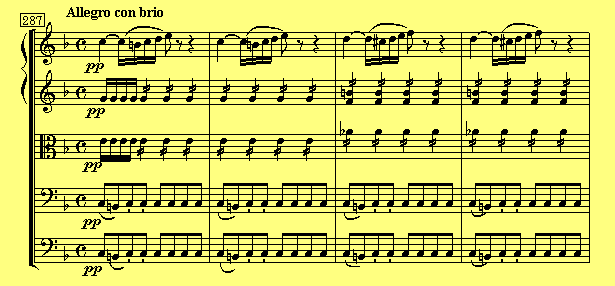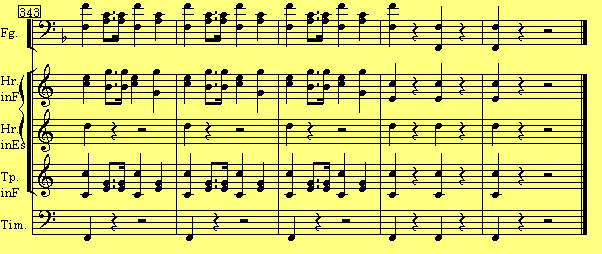
(4)
4.Interpretation (the 3rd part)
4/4 allegro con brio, “victorious song” starts.
This part fits to that is quoted “the last stage direction”, and music of same melody is performed at last in the actual drama.
It turns on other subjects let me introduce what Goethe imagines at the last scene.
“When a goddess of liberty of looking Kl?rchen is going to give a victorious laurel crown to Egmonto, he hears sounds of war by drum and flute from the distance. As the sounds get louder he awakes, he is encouraged by the approaching sound of drum, and he walks toward the guillotine.”
Goethe writes the sounds by drum and flute here, but Beethoven uses trumpet in insert music. Only last several times of sound of drum are recognized.
Considering its reason, in those days (there were people that
saw execution actually with their own eyes) the sound of drum
was too real that suggests “guillotine”. It’s entirely
my guess.
Many nobles were sent to guillotine during the French
Revolution, it’s still fresh in our memory, so I think people
even not be noble may hated to remember its cruelty.
About 15 years after that Hector Berlioz writes “Symphonie
Fantastique”. Series of drum at the scene of guillotine is
so symbolic. In those days Beethoven seems to consider that
people does not feel terror rather than victory.
In the opera “Fidelio” arrival of Cabinet minister is informed by trumpet as symbol of justice that is salvaged at last. In the same manner Beethoven makes trumpet announce victory.
Also in this overture there is a fanfare by trumpet and horn at last. It is as sign of “victory song” of “free independence of folkways”.
Beginning of last
I explained at choral of goddess of liberty, it is sure to describe the design of Goethe’s origin as it is.
That is, it’s the scene that the voice of uprising people approaches gradually from distance.
Tick of sixteenth of Ⅱviolin and viola and tremolo of timpani represent sound that people come to meet together stirringly. ♪ of violoncello and double bass, especially first two are tied with slur, represent “uneasiness” like somewhat “expectation”.
Notes of woodwind instrument change from whole note
through quarter note and eight note at a stretch to sixteenth
note at last (flute and piccolo). This change represents straight
first to listen for with “?” second that slight expectation
rises up to positive proof. It suggests process of Egmont awaking
from dream.

Melody of Ⅰviolin heard from beginning tells that Egmont progresses backward the motif that he appealed to people and Oranien in the 1st part and “takes firm root” in them. And it becomes melody of “victorious song” and accomplishes.
“Victorious song”
From bar 295 “victorious song” should be sung as aloud as possible.
Not to become “spree”, you may not pay attention only to“sf ”.
Or it starts from the “sf ” and auftact is missing.
Motif of Ⅰviolin from bar 287 progresses backward the motif that Egmont persuades Oranien and people in the beginning bar 15. It puts intonation of “?” and creates hope to “attainment of object”.
It is understandable that bar 295 develops from this motif, but it must not to be considered as a simple magnification.
“Answer” for motif of “?” of bar 287 is the first half note. It can become motif of “final victory”. Because three ♪ from 3 beat back lead toward the tone with “sf “on head of next time, that is “answer”.
This first “answer” is “outcry”, but it develops to
three times downward of ♪ during bars 229-300, and repeats
further. Its form is magnified more and is showed clearly from
bar 307.
By this development of motif, simple “outcry of joy” turns
into “relief for peace”.
Before long these “outcry” and “relief” come to repeat for larger type of “praise for Egmont”.

Please confirm that the motif of beginning varies so much once more.
Praise for Egmont
Melody of ? with “sf “ of fagotto, viola and violoncello from bar 307 is variation of Egmont’s persuasive tone of beginning by oboe. Voices that people praise are sang flowery by violin and woodwind instrument and from bar 309 by Ⅰ&Ⅱ violin and flute in contraction.
After this his motif is stressed many times in larger type to praise greatness of his insistence.
Fanfare for victory
All is concluded by the first sound of bar 343.

Fanfare by fagotto, horn and trumpet from second time “declares victory” aloud.
Rhythm of this motif is that of “Freemason” that Mozart also used. Therefore the relation is imaginable somehow. Whether it's true or not the slogan of the society is “freedom, philanthropy, equality”. It's also the slogan of French Revolution and “thought as the general will of people” in those days perhaps.
It is understandable that this symbolic rhythm is used here.
5.After interpretation
This much is all I interpreted.
Such interpretation must force a burden to reader so much. As I commented at first, to describe things that we think in our mind at a moment needs a lots of words and becomes complex. I think you understand that.
But while Beethoven composes he thinks much more and polishes up afterward many times. Finally this work is constructed.
After this interpretation it is proved that Beethoven’s thought was very logical. Because I could understand even to detail without many doubts.
This point may be the proof that this composer Beethoven is great.
END